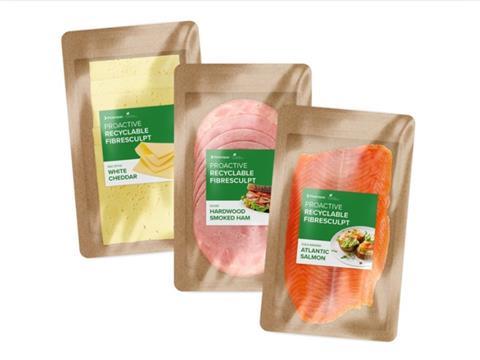
ProAmpac is launching a 90% fibre-based, high-barrier thermoforming solution on the European market in hopes of unlocking recyclability, efficiency, and consumer appeal for a range of food packaging.
Compared to thermoformed flexible, rigid, or semi-rigid alternatives, ProActive Recyclable FibreSculpt is said to be lightweight and cut down on unnecessary packaging. It is designed to fulfil consumer demand for renewable packaging materials and provide brands with premium aesthetics and an enhanced shelf appeal.
According to ProAmpac, the packaging is OPRL compliant and contains over 90% fibre. This means it is kerbside recyclable in the UK and Ireland, which is hoped to bring customers a step closer to achieving circularity for their packaging.
Additionally, it has been engineered to maintain the speed of a thermoforming line. It is reported to offer a higher yield per roll, improve transportation efficiency, and lower changeover times on the filling line.
ProActive Recyclable FibreSculpt is set to package chilled cooked meats, cold cuts, sliced cheese, fish, and other edible products.
“ProActive Recyclable FibreSculpt has excellent grease resistance for optimum shelf appearance and a very high barrier to maintain product shelf life,” explains Adam West, ProAmpac’s product development engineer in Europe. “Coupled with ProAmpac’s high-barrier top web solutions with paper texture, ProActive Recyclable FibreSculpt provides customers with a more sustainable and premium flexible packaging platform.”
“ProActive Recyclable FibreSculpt complies with OPRL guidelines and boasts over 90% fibre content,” adds Ali McNulty, market manager at ProAmpac. “This latest innovation underscores ProAmpac’s unwavering commitment to helping brands meet their sustainability goals.”
In related news, Coveris’ mono-material thermoforming solution, MonoFlex Thermoform, was released late last year. It seeks to replace non-recyclable mixed materials in thermoformed food packaging.
SEE (formerly Sealed Air) also developed a paper-based bottom web to reduce the consumption of plastic in food processing and retail applications, as well as meet consumer demand for paper-based packaging.
If you liked this article, you might also enjoy:
The Lidl approach to packaging sustainability
How did Brazil achieve its 100% aluminium can recycling rate – and can it be replicated in the EU?
Experts have their say on the EU’s Packaging and Packaging Waste Directive revisions
A deep dive into the most important packaging sustainability trends and solutions












No comments yet